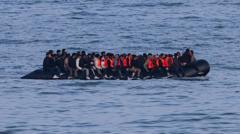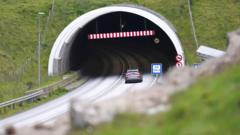The Fehmarnbelt tunnel, the world's longest pre-fabricated road and rail tunnel, aims to enhance accessibility and reduce travel times significantly.
**Denmark-Germany Tunnel: A Revolutionary Link for Europe**

**Denmark-Germany Tunnel: A Revolutionary Link for Europe**
A groundbreaking tunnel beneath the Baltic Sea promises to transform travel between Denmark and Germany.
The construction of an unprecedented tunnel from Denmark to Germany under the Baltic Sea is set to revolutionize transportation links across Europe. Known as the Fehmarnbelt, this engineering marvel will span 18 kilometers (11 miles), establishing itself as the longest pre-fabricated road and rail tunnel globally and promising a remarkable reduction in travel times between major urban centers.
Current estimates place the tunnel's completion in 2029. Once finalized, the drive from Rødbyhavn in Denmark to Puttgarten in Germany will take a mere 10 minutes, while trains will cover the same distance in just 7 minutes—previously requiring a 45-minute ferry ride. This ambitious project not only connects Denmark with Germany but also strengthens the entire Scandinavian region's ties with Central Europe, slashing travel times between Copenhagen and Hamburg from five to just 2.5 hours.
The tunnel's construction, with a budget around €7.4 billion ($8.1 billion), is largely funded by Denmark, complemented by €1.3 billion from the European Commission. The construction site, spanning over 500 hectares (1,235 acres) on the island of Lolland, houses a state-of-the-art facility for producing the 90 individual tunnel segments, or "elements." Each segment, measuring 217 meters (712 feet) long and 42 meters wide, is made from reinforced steel and concrete, and will be installed using a unique “Lego brick” method on the seabed.
Anders Gert Wede, senior construction manager, noted the remarkable nature of the project amidst the beautiful but challenging backdrop of the Baltic Sea. Originally, a bridge was under consideration, but strong winds and safety concerns related to shipping traffic led engineers to favor the tunnel. Environmental advocates raised alarms over the potential ecological impact, specifically on local species such as porpoises, but legal challenges were ultimately resolved in favor of construction.
To mitigate environmental concerns, project managers have committed to efforts such as creating a 300-hectare wetland area on reclaimed land designed to encourage biodiversity. With projections estimating over 100 trains and 12,000 cars crossing daily after its opening, the tunnel is expected to invigorate the economy of Lolland, a region historically marked by poverty, promising job creation and increased tourism.
As the region anticipates the tunnel's significant impact, local sentiments are high. "People are excited for businesses to find their way here," remarked Wede, offering a glimpse into the transformative potential of this ambitious infrastructure project for both communities involved.
Current estimates place the tunnel's completion in 2029. Once finalized, the drive from Rødbyhavn in Denmark to Puttgarten in Germany will take a mere 10 minutes, while trains will cover the same distance in just 7 minutes—previously requiring a 45-minute ferry ride. This ambitious project not only connects Denmark with Germany but also strengthens the entire Scandinavian region's ties with Central Europe, slashing travel times between Copenhagen and Hamburg from five to just 2.5 hours.
The tunnel's construction, with a budget around €7.4 billion ($8.1 billion), is largely funded by Denmark, complemented by €1.3 billion from the European Commission. The construction site, spanning over 500 hectares (1,235 acres) on the island of Lolland, houses a state-of-the-art facility for producing the 90 individual tunnel segments, or "elements." Each segment, measuring 217 meters (712 feet) long and 42 meters wide, is made from reinforced steel and concrete, and will be installed using a unique “Lego brick” method on the seabed.
Anders Gert Wede, senior construction manager, noted the remarkable nature of the project amidst the beautiful but challenging backdrop of the Baltic Sea. Originally, a bridge was under consideration, but strong winds and safety concerns related to shipping traffic led engineers to favor the tunnel. Environmental advocates raised alarms over the potential ecological impact, specifically on local species such as porpoises, but legal challenges were ultimately resolved in favor of construction.
To mitigate environmental concerns, project managers have committed to efforts such as creating a 300-hectare wetland area on reclaimed land designed to encourage biodiversity. With projections estimating over 100 trains and 12,000 cars crossing daily after its opening, the tunnel is expected to invigorate the economy of Lolland, a region historically marked by poverty, promising job creation and increased tourism.
As the region anticipates the tunnel's significant impact, local sentiments are high. "People are excited for businesses to find their way here," remarked Wede, offering a glimpse into the transformative potential of this ambitious infrastructure project for both communities involved.





















